Managing Human Resources: Employee Wellbeing and Legal Considerations
VerifiedAdded on 2022/08/18
|13
|3725
|14
Essay
AI Summary
This essay explores the critical role of human resource management in fostering employee wellbeing and its impact on organizational success. The author defines employee wellbeing, encompassing physical and mental health, job satisfaction, and work-life balance, while also examining the legal perspectives on employer interference in employees' lifestyles. The essay delves into the importance of employee wellbeing initiatives, highlighting the benefits of increased morale, motivation, and productivity. It also addresses the limits of such practices, such as lack of investment and managerial skills. The essay provides a case study of Tesco UK's efforts to promote employee wellbeing through various programs and policies, including family-friendly measures, health services, and initiatives to prevent discrimination. The essay concludes by emphasizing the significance of employee wellbeing for creating a healthy, engaged, and productive workforce and the need to balance employer interventions with employee privacy.
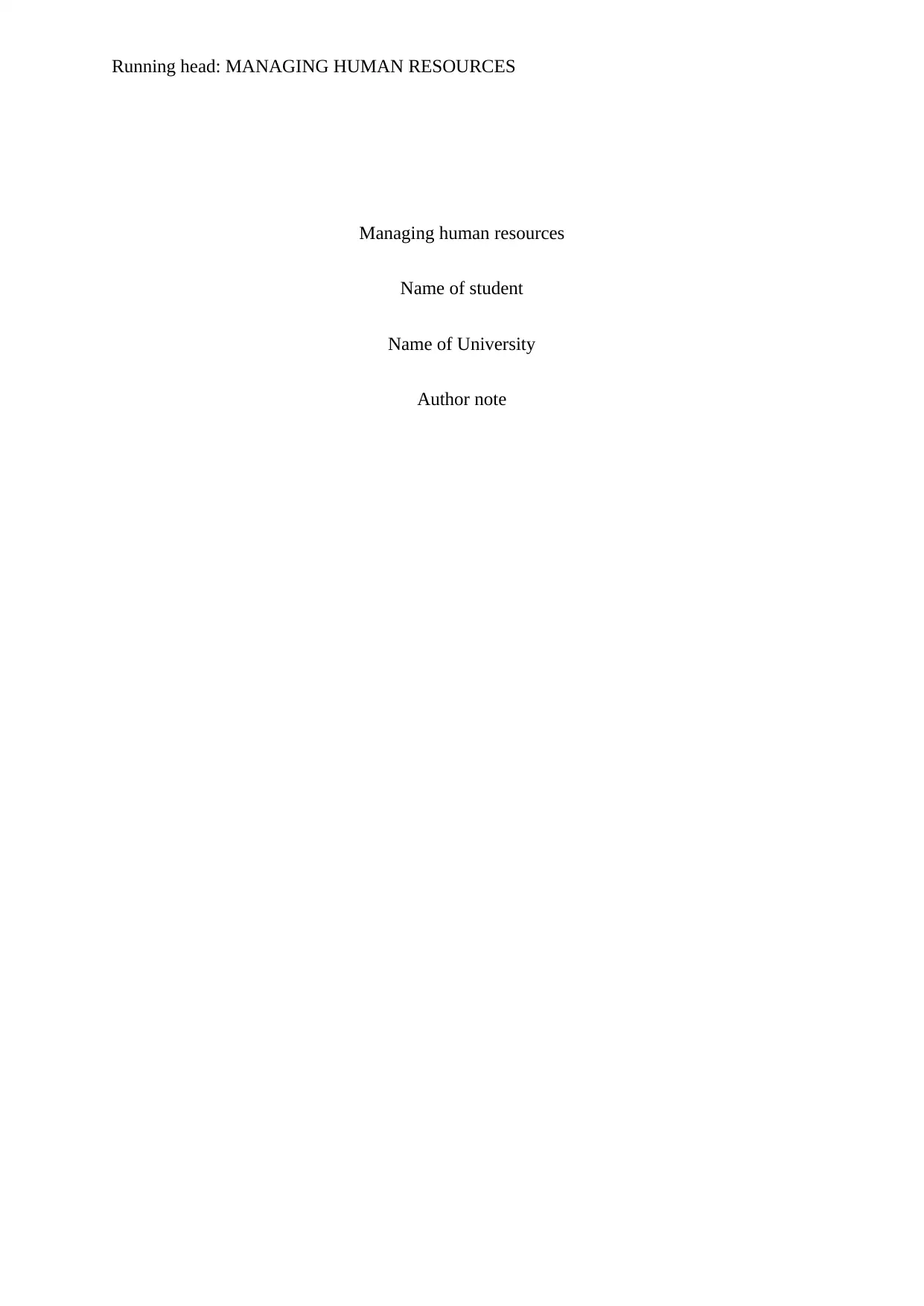
Running head: MANAGING HUMAN RESOURCES
Managing human resources
Name of student
Name of University
Author note
Managing human resources
Name of student
Name of University
Author note
Paraphrase This Document
Need a fresh take? Get an instant paraphrase of this document with our AI Paraphraser
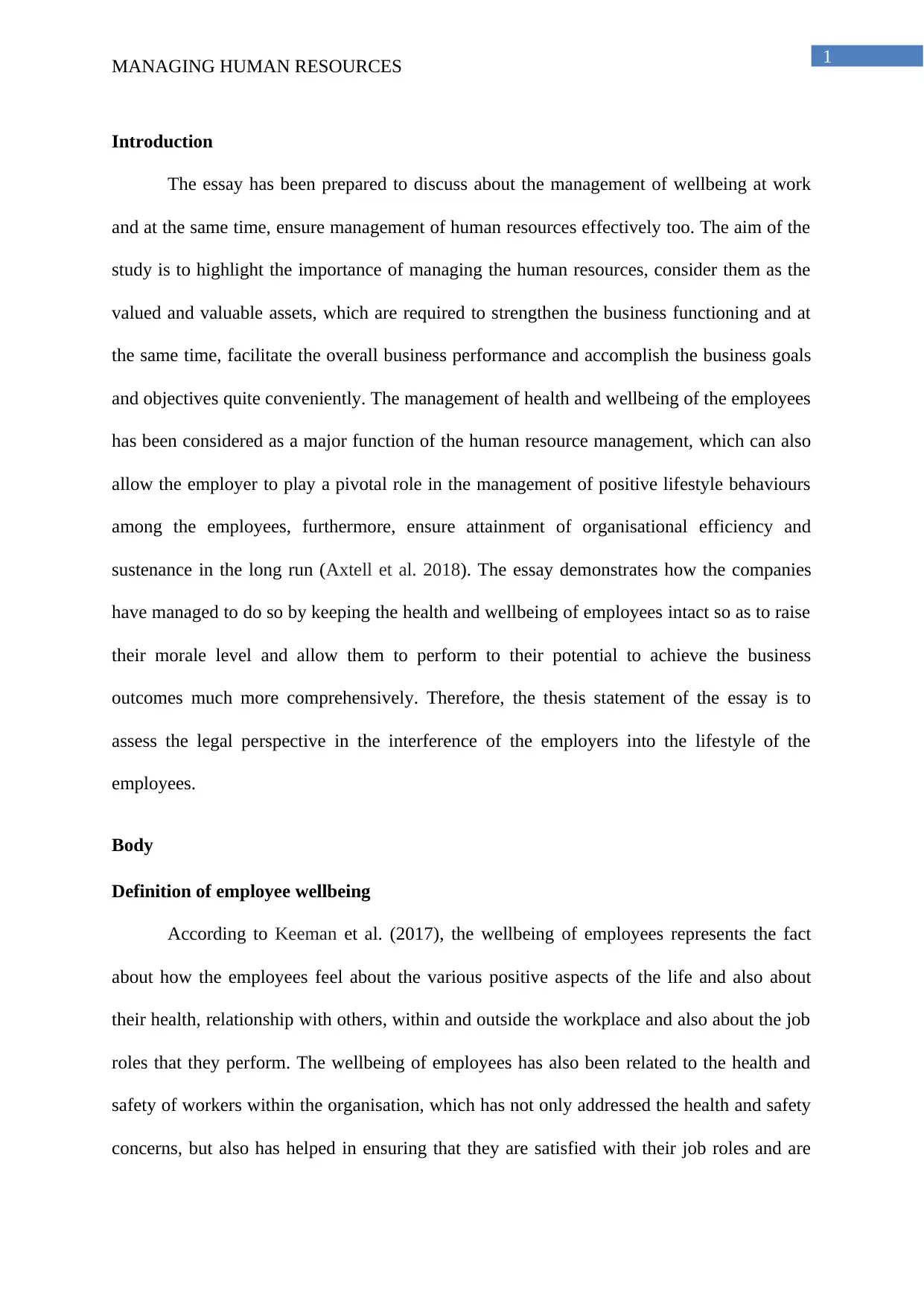
1
MANAGING HUMAN RESOURCES
Introduction
The essay has been prepared to discuss about the management of wellbeing at work
and at the same time, ensure management of human resources effectively too. The aim of the
study is to highlight the importance of managing the human resources, consider them as the
valued and valuable assets, which are required to strengthen the business functioning and at
the same time, facilitate the overall business performance and accomplish the business goals
and objectives quite conveniently. The management of health and wellbeing of the employees
has been considered as a major function of the human resource management, which can also
allow the employer to play a pivotal role in the management of positive lifestyle behaviours
among the employees, furthermore, ensure attainment of organisational efficiency and
sustenance in the long run (Axtell et al. 2018). The essay demonstrates how the companies
have managed to do so by keeping the health and wellbeing of employees intact so as to raise
their morale level and allow them to perform to their potential to achieve the business
outcomes much more comprehensively. Therefore, the thesis statement of the essay is to
assess the legal perspective in the interference of the employers into the lifestyle of the
employees.
Body
Definition of employee wellbeing
According to Keeman et al. (2017), the wellbeing of employees represents the fact
about how the employees feel about the various positive aspects of the life and also about
their health, relationship with others, within and outside the workplace and also about the job
roles that they perform. The wellbeing of employees has also been related to the health and
safety of workers within the organisation, which has not only addressed the health and safety
concerns, but also has helped in ensuring that they are satisfied with their job roles and are
MANAGING HUMAN RESOURCES
Introduction
The essay has been prepared to discuss about the management of wellbeing at work
and at the same time, ensure management of human resources effectively too. The aim of the
study is to highlight the importance of managing the human resources, consider them as the
valued and valuable assets, which are required to strengthen the business functioning and at
the same time, facilitate the overall business performance and accomplish the business goals
and objectives quite conveniently. The management of health and wellbeing of the employees
has been considered as a major function of the human resource management, which can also
allow the employer to play a pivotal role in the management of positive lifestyle behaviours
among the employees, furthermore, ensure attainment of organisational efficiency and
sustenance in the long run (Axtell et al. 2018). The essay demonstrates how the companies
have managed to do so by keeping the health and wellbeing of employees intact so as to raise
their morale level and allow them to perform to their potential to achieve the business
outcomes much more comprehensively. Therefore, the thesis statement of the essay is to
assess the legal perspective in the interference of the employers into the lifestyle of the
employees.
Body
Definition of employee wellbeing
According to Keeman et al. (2017), the wellbeing of employees represents the fact
about how the employees feel about the various positive aspects of the life and also about
their health, relationship with others, within and outside the workplace and also about the job
roles that they perform. The wellbeing of employees has also been related to the health and
safety of workers within the organisation, which has not only addressed the health and safety
concerns, but also has helped in ensuring that they are satisfied with their job roles and are
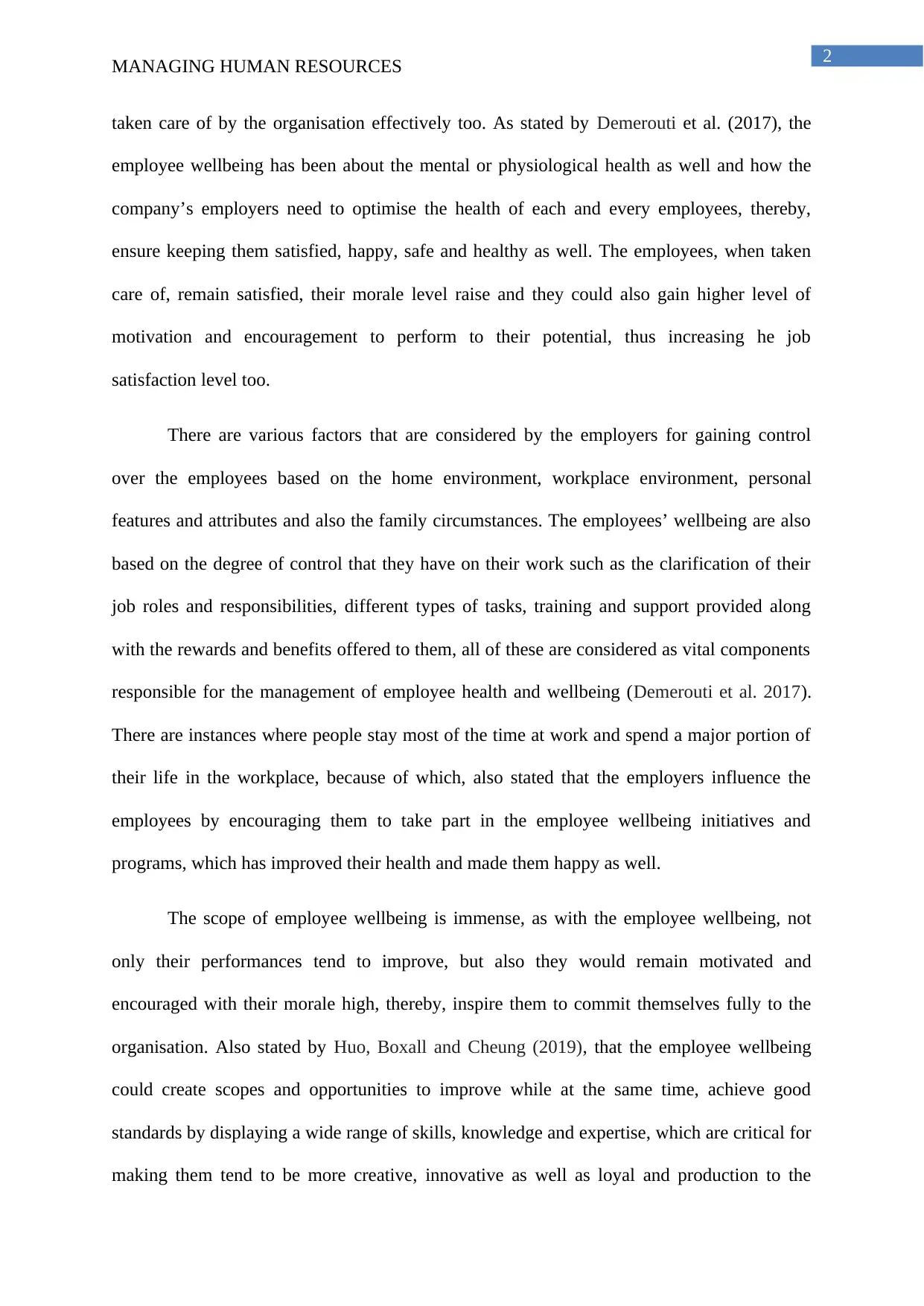
2
MANAGING HUMAN RESOURCES
taken care of by the organisation effectively too. As stated by Demerouti et al. (2017), the
employee wellbeing has been about the mental or physiological health as well and how the
company’s employers need to optimise the health of each and every employees, thereby,
ensure keeping them satisfied, happy, safe and healthy as well. The employees, when taken
care of, remain satisfied, their morale level raise and they could also gain higher level of
motivation and encouragement to perform to their potential, thus increasing he job
satisfaction level too.
There are various factors that are considered by the employers for gaining control
over the employees based on the home environment, workplace environment, personal
features and attributes and also the family circumstances. The employees’ wellbeing are also
based on the degree of control that they have on their work such as the clarification of their
job roles and responsibilities, different types of tasks, training and support provided along
with the rewards and benefits offered to them, all of these are considered as vital components
responsible for the management of employee health and wellbeing (Demerouti et al. 2017).
There are instances where people stay most of the time at work and spend a major portion of
their life in the workplace, because of which, also stated that the employers influence the
employees by encouraging them to take part in the employee wellbeing initiatives and
programs, which has improved their health and made them happy as well.
The scope of employee wellbeing is immense, as with the employee wellbeing, not
only their performances tend to improve, but also they would remain motivated and
encouraged with their morale high, thereby, inspire them to commit themselves fully to the
organisation. Also stated by Huo, Boxall and Cheung (2019), that the employee wellbeing
could create scopes and opportunities to improve while at the same time, achieve good
standards by displaying a wide range of skills, knowledge and expertise, which are critical for
making them tend to be more creative, innovative as well as loyal and production to the
MANAGING HUMAN RESOURCES
taken care of by the organisation effectively too. As stated by Demerouti et al. (2017), the
employee wellbeing has been about the mental or physiological health as well and how the
company’s employers need to optimise the health of each and every employees, thereby,
ensure keeping them satisfied, happy, safe and healthy as well. The employees, when taken
care of, remain satisfied, their morale level raise and they could also gain higher level of
motivation and encouragement to perform to their potential, thus increasing he job
satisfaction level too.
There are various factors that are considered by the employers for gaining control
over the employees based on the home environment, workplace environment, personal
features and attributes and also the family circumstances. The employees’ wellbeing are also
based on the degree of control that they have on their work such as the clarification of their
job roles and responsibilities, different types of tasks, training and support provided along
with the rewards and benefits offered to them, all of these are considered as vital components
responsible for the management of employee health and wellbeing (Demerouti et al. 2017).
There are instances where people stay most of the time at work and spend a major portion of
their life in the workplace, because of which, also stated that the employers influence the
employees by encouraging them to take part in the employee wellbeing initiatives and
programs, which has improved their health and made them happy as well.
The scope of employee wellbeing is immense, as with the employee wellbeing, not
only their performances tend to improve, but also they would remain motivated and
encouraged with their morale high, thereby, inspire them to commit themselves fully to the
organisation. Also stated by Huo, Boxall and Cheung (2019), that the employee wellbeing
could create scopes and opportunities to improve while at the same time, achieve good
standards by displaying a wide range of skills, knowledge and expertise, which are critical for
making them tend to be more creative, innovative as well as loyal and production to the
⊘ This is a preview!⊘
Do you want full access?
Subscribe today to unlock all pages.

Trusted by 1+ million students worldwide
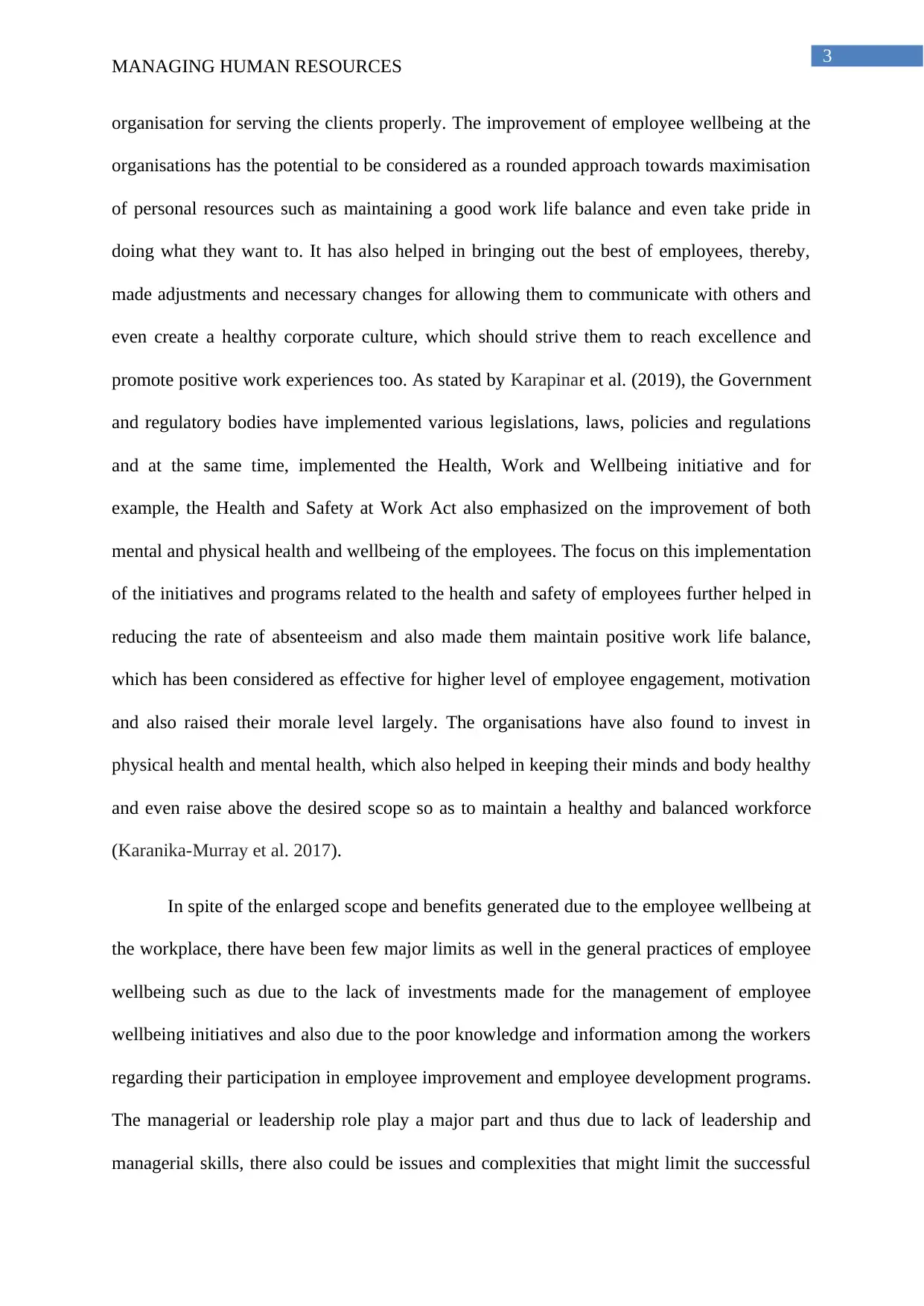
3
MANAGING HUMAN RESOURCES
organisation for serving the clients properly. The improvement of employee wellbeing at the
organisations has the potential to be considered as a rounded approach towards maximisation
of personal resources such as maintaining a good work life balance and even take pride in
doing what they want to. It has also helped in bringing out the best of employees, thereby,
made adjustments and necessary changes for allowing them to communicate with others and
even create a healthy corporate culture, which should strive them to reach excellence and
promote positive work experiences too. As stated by Karapinar et al. (2019), the Government
and regulatory bodies have implemented various legislations, laws, policies and regulations
and at the same time, implemented the Health, Work and Wellbeing initiative and for
example, the Health and Safety at Work Act also emphasized on the improvement of both
mental and physical health and wellbeing of the employees. The focus on this implementation
of the initiatives and programs related to the health and safety of employees further helped in
reducing the rate of absenteeism and also made them maintain positive work life balance,
which has been considered as effective for higher level of employee engagement, motivation
and also raised their morale level largely. The organisations have also found to invest in
physical health and mental health, which also helped in keeping their minds and body healthy
and even raise above the desired scope so as to maintain a healthy and balanced workforce
(Karanika-Murray et al. 2017).
In spite of the enlarged scope and benefits generated due to the employee wellbeing at
the workplace, there have been few major limits as well in the general practices of employee
wellbeing such as due to the lack of investments made for the management of employee
wellbeing initiatives and also due to the poor knowledge and information among the workers
regarding their participation in employee improvement and employee development programs.
The managerial or leadership role play a major part and thus due to lack of leadership and
managerial skills, there also could be issues and complexities that might limit the successful
MANAGING HUMAN RESOURCES
organisation for serving the clients properly. The improvement of employee wellbeing at the
organisations has the potential to be considered as a rounded approach towards maximisation
of personal resources such as maintaining a good work life balance and even take pride in
doing what they want to. It has also helped in bringing out the best of employees, thereby,
made adjustments and necessary changes for allowing them to communicate with others and
even create a healthy corporate culture, which should strive them to reach excellence and
promote positive work experiences too. As stated by Karapinar et al. (2019), the Government
and regulatory bodies have implemented various legislations, laws, policies and regulations
and at the same time, implemented the Health, Work and Wellbeing initiative and for
example, the Health and Safety at Work Act also emphasized on the improvement of both
mental and physical health and wellbeing of the employees. The focus on this implementation
of the initiatives and programs related to the health and safety of employees further helped in
reducing the rate of absenteeism and also made them maintain positive work life balance,
which has been considered as effective for higher level of employee engagement, motivation
and also raised their morale level largely. The organisations have also found to invest in
physical health and mental health, which also helped in keeping their minds and body healthy
and even raise above the desired scope so as to maintain a healthy and balanced workforce
(Karanika-Murray et al. 2017).
In spite of the enlarged scope and benefits generated due to the employee wellbeing at
the workplace, there have been few major limits as well in the general practices of employee
wellbeing such as due to the lack of investments made for the management of employee
wellbeing initiatives and also due to the poor knowledge and information among the workers
regarding their participation in employee improvement and employee development programs.
The managerial or leadership role play a major part and thus due to lack of leadership and
managerial skills, there also could be issues and complexities that might limit the successful
Paraphrase This Document
Need a fresh take? Get an instant paraphrase of this document with our AI Paraphraser
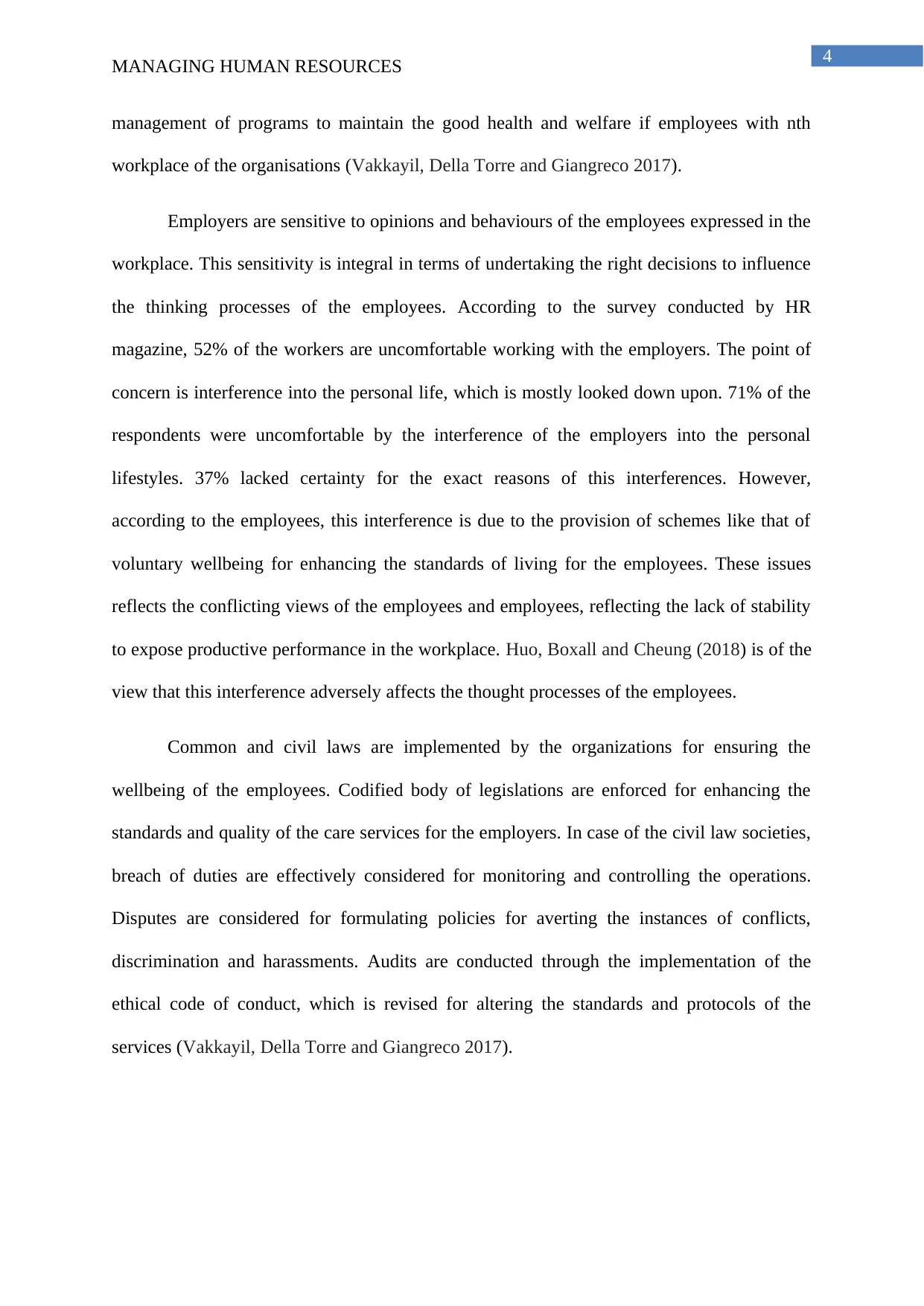
4
MANAGING HUMAN RESOURCES
management of programs to maintain the good health and welfare if employees with nth
workplace of the organisations (Vakkayil, Della Torre and Giangreco 2017).
Employers are sensitive to opinions and behaviours of the employees expressed in the
workplace. This sensitivity is integral in terms of undertaking the right decisions to influence
the thinking processes of the employees. According to the survey conducted by HR
magazine, 52% of the workers are uncomfortable working with the employers. The point of
concern is interference into the personal life, which is mostly looked down upon. 71% of the
respondents were uncomfortable by the interference of the employers into the personal
lifestyles. 37% lacked certainty for the exact reasons of this interferences. However,
according to the employees, this interference is due to the provision of schemes like that of
voluntary wellbeing for enhancing the standards of living for the employees. These issues
reflects the conflicting views of the employees and employees, reflecting the lack of stability
to expose productive performance in the workplace. Huo, Boxall and Cheung (2018) is of the
view that this interference adversely affects the thought processes of the employees.
Common and civil laws are implemented by the organizations for ensuring the
wellbeing of the employees. Codified body of legislations are enforced for enhancing the
standards and quality of the care services for the employers. In case of the civil law societies,
breach of duties are effectively considered for monitoring and controlling the operations.
Disputes are considered for formulating policies for averting the instances of conflicts,
discrimination and harassments. Audits are conducted through the implementation of the
ethical code of conduct, which is revised for altering the standards and protocols of the
services (Vakkayil, Della Torre and Giangreco 2017).
MANAGING HUMAN RESOURCES
management of programs to maintain the good health and welfare if employees with nth
workplace of the organisations (Vakkayil, Della Torre and Giangreco 2017).
Employers are sensitive to opinions and behaviours of the employees expressed in the
workplace. This sensitivity is integral in terms of undertaking the right decisions to influence
the thinking processes of the employees. According to the survey conducted by HR
magazine, 52% of the workers are uncomfortable working with the employers. The point of
concern is interference into the personal life, which is mostly looked down upon. 71% of the
respondents were uncomfortable by the interference of the employers into the personal
lifestyles. 37% lacked certainty for the exact reasons of this interferences. However,
according to the employees, this interference is due to the provision of schemes like that of
voluntary wellbeing for enhancing the standards of living for the employees. These issues
reflects the conflicting views of the employees and employees, reflecting the lack of stability
to expose productive performance in the workplace. Huo, Boxall and Cheung (2018) is of the
view that this interference adversely affects the thought processes of the employees.
Common and civil laws are implemented by the organizations for ensuring the
wellbeing of the employees. Codified body of legislations are enforced for enhancing the
standards and quality of the care services for the employers. In case of the civil law societies,
breach of duties are effectively considered for monitoring and controlling the operations.
Disputes are considered for formulating policies for averting the instances of conflicts,
discrimination and harassments. Audits are conducted through the implementation of the
ethical code of conduct, which is revised for altering the standards and protocols of the
services (Vakkayil, Della Torre and Giangreco 2017).
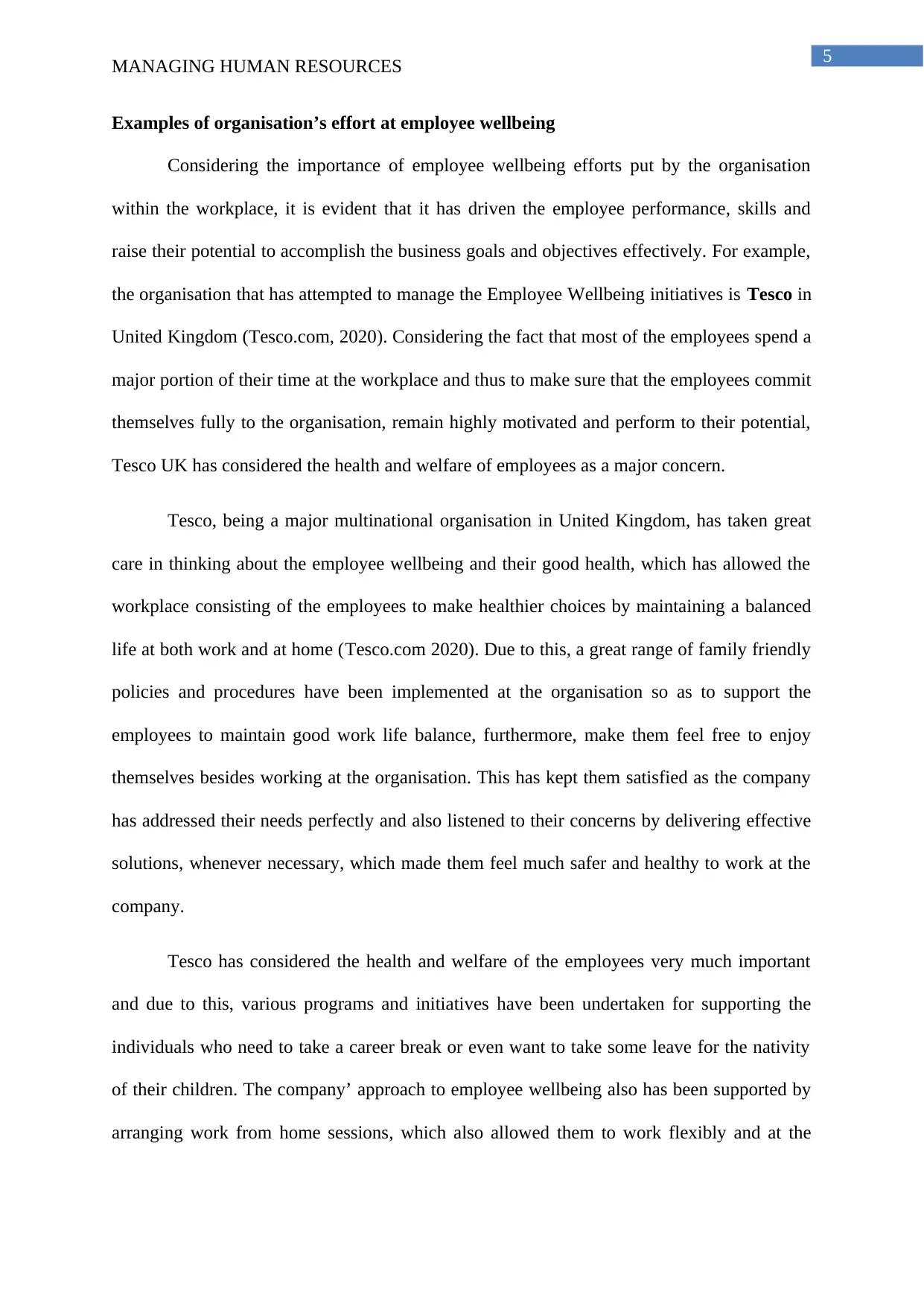
5
MANAGING HUMAN RESOURCES
Examples of organisation’s effort at employee wellbeing
Considering the importance of employee wellbeing efforts put by the organisation
within the workplace, it is evident that it has driven the employee performance, skills and
raise their potential to accomplish the business goals and objectives effectively. For example,
the organisation that has attempted to manage the Employee Wellbeing initiatives is Tesco in
United Kingdom (Tesco.com, 2020). Considering the fact that most of the employees spend a
major portion of their time at the workplace and thus to make sure that the employees commit
themselves fully to the organisation, remain highly motivated and perform to their potential,
Tesco UK has considered the health and welfare of employees as a major concern.
Tesco, being a major multinational organisation in United Kingdom, has taken great
care in thinking about the employee wellbeing and their good health, which has allowed the
workplace consisting of the employees to make healthier choices by maintaining a balanced
life at both work and at home (Tesco.com 2020). Due to this, a great range of family friendly
policies and procedures have been implemented at the organisation so as to support the
employees to maintain good work life balance, furthermore, make them feel free to enjoy
themselves besides working at the organisation. This has kept them satisfied as the company
has addressed their needs perfectly and also listened to their concerns by delivering effective
solutions, whenever necessary, which made them feel much safer and healthy to work at the
company.
Tesco has considered the health and welfare of the employees very much important
and due to this, various programs and initiatives have been undertaken for supporting the
individuals who need to take a career break or even want to take some leave for the nativity
of their children. The company’ approach to employee wellbeing also has been supported by
arranging work from home sessions, which also allowed them to work flexibly and at the
MANAGING HUMAN RESOURCES
Examples of organisation’s effort at employee wellbeing
Considering the importance of employee wellbeing efforts put by the organisation
within the workplace, it is evident that it has driven the employee performance, skills and
raise their potential to accomplish the business goals and objectives effectively. For example,
the organisation that has attempted to manage the Employee Wellbeing initiatives is Tesco in
United Kingdom (Tesco.com, 2020). Considering the fact that most of the employees spend a
major portion of their time at the workplace and thus to make sure that the employees commit
themselves fully to the organisation, remain highly motivated and perform to their potential,
Tesco UK has considered the health and welfare of employees as a major concern.
Tesco, being a major multinational organisation in United Kingdom, has taken great
care in thinking about the employee wellbeing and their good health, which has allowed the
workplace consisting of the employees to make healthier choices by maintaining a balanced
life at both work and at home (Tesco.com 2020). Due to this, a great range of family friendly
policies and procedures have been implemented at the organisation so as to support the
employees to maintain good work life balance, furthermore, make them feel free to enjoy
themselves besides working at the organisation. This has kept them satisfied as the company
has addressed their needs perfectly and also listened to their concerns by delivering effective
solutions, whenever necessary, which made them feel much safer and healthy to work at the
company.
Tesco has considered the health and welfare of the employees very much important
and due to this, various programs and initiatives have been undertaken for supporting the
individuals who need to take a career break or even want to take some leave for the nativity
of their children. The company’ approach to employee wellbeing also has been supported by
arranging work from home sessions, which also allowed them to work flexibly and at the
⊘ This is a preview!⊘
Do you want full access?
Subscribe today to unlock all pages.

Trusted by 1+ million students worldwide
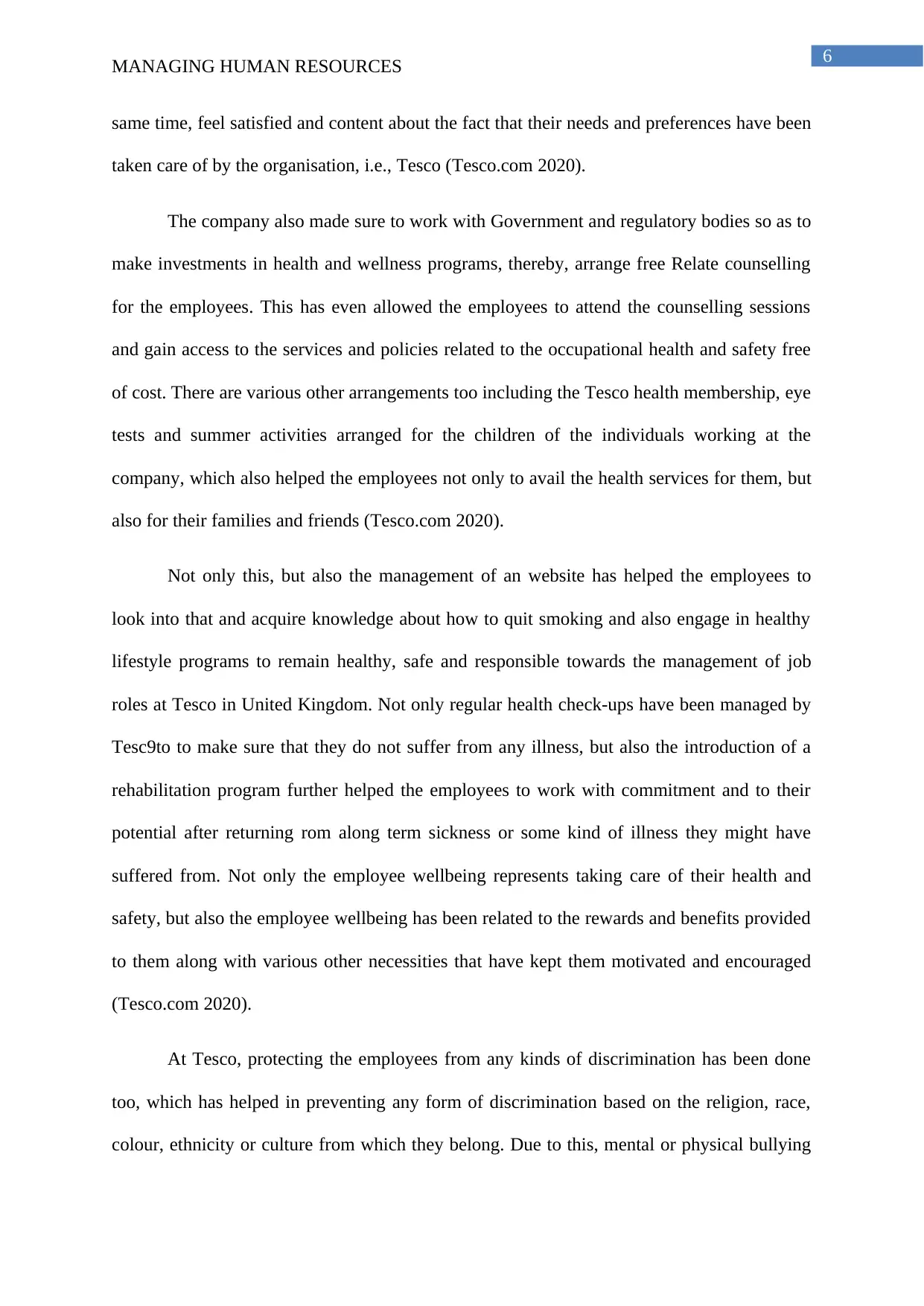
6
MANAGING HUMAN RESOURCES
same time, feel satisfied and content about the fact that their needs and preferences have been
taken care of by the organisation, i.e., Tesco (Tesco.com 2020).
The company also made sure to work with Government and regulatory bodies so as to
make investments in health and wellness programs, thereby, arrange free Relate counselling
for the employees. This has even allowed the employees to attend the counselling sessions
and gain access to the services and policies related to the occupational health and safety free
of cost. There are various other arrangements too including the Tesco health membership, eye
tests and summer activities arranged for the children of the individuals working at the
company, which also helped the employees not only to avail the health services for them, but
also for their families and friends (Tesco.com 2020).
Not only this, but also the management of an website has helped the employees to
look into that and acquire knowledge about how to quit smoking and also engage in healthy
lifestyle programs to remain healthy, safe and responsible towards the management of job
roles at Tesco in United Kingdom. Not only regular health check-ups have been managed by
Tesc9to to make sure that they do not suffer from any illness, but also the introduction of a
rehabilitation program further helped the employees to work with commitment and to their
potential after returning rom along term sickness or some kind of illness they might have
suffered from. Not only the employee wellbeing represents taking care of their health and
safety, but also the employee wellbeing has been related to the rewards and benefits provided
to them along with various other necessities that have kept them motivated and encouraged
(Tesco.com 2020).
At Tesco, protecting the employees from any kinds of discrimination has been done
too, which has helped in preventing any form of discrimination based on the religion, race,
colour, ethnicity or culture from which they belong. Due to this, mental or physical bullying
MANAGING HUMAN RESOURCES
same time, feel satisfied and content about the fact that their needs and preferences have been
taken care of by the organisation, i.e., Tesco (Tesco.com 2020).
The company also made sure to work with Government and regulatory bodies so as to
make investments in health and wellness programs, thereby, arrange free Relate counselling
for the employees. This has even allowed the employees to attend the counselling sessions
and gain access to the services and policies related to the occupational health and safety free
of cost. There are various other arrangements too including the Tesco health membership, eye
tests and summer activities arranged for the children of the individuals working at the
company, which also helped the employees not only to avail the health services for them, but
also for their families and friends (Tesco.com 2020).
Not only this, but also the management of an website has helped the employees to
look into that and acquire knowledge about how to quit smoking and also engage in healthy
lifestyle programs to remain healthy, safe and responsible towards the management of job
roles at Tesco in United Kingdom. Not only regular health check-ups have been managed by
Tesc9to to make sure that they do not suffer from any illness, but also the introduction of a
rehabilitation program further helped the employees to work with commitment and to their
potential after returning rom along term sickness or some kind of illness they might have
suffered from. Not only the employee wellbeing represents taking care of their health and
safety, but also the employee wellbeing has been related to the rewards and benefits provided
to them along with various other necessities that have kept them motivated and encouraged
(Tesco.com 2020).
At Tesco, protecting the employees from any kinds of discrimination has been done
too, which has helped in preventing any form of discrimination based on the religion, race,
colour, ethnicity or culture from which they belong. Due to this, mental or physical bullying
Paraphrase This Document
Need a fresh take? Get an instant paraphrase of this document with our AI Paraphraser
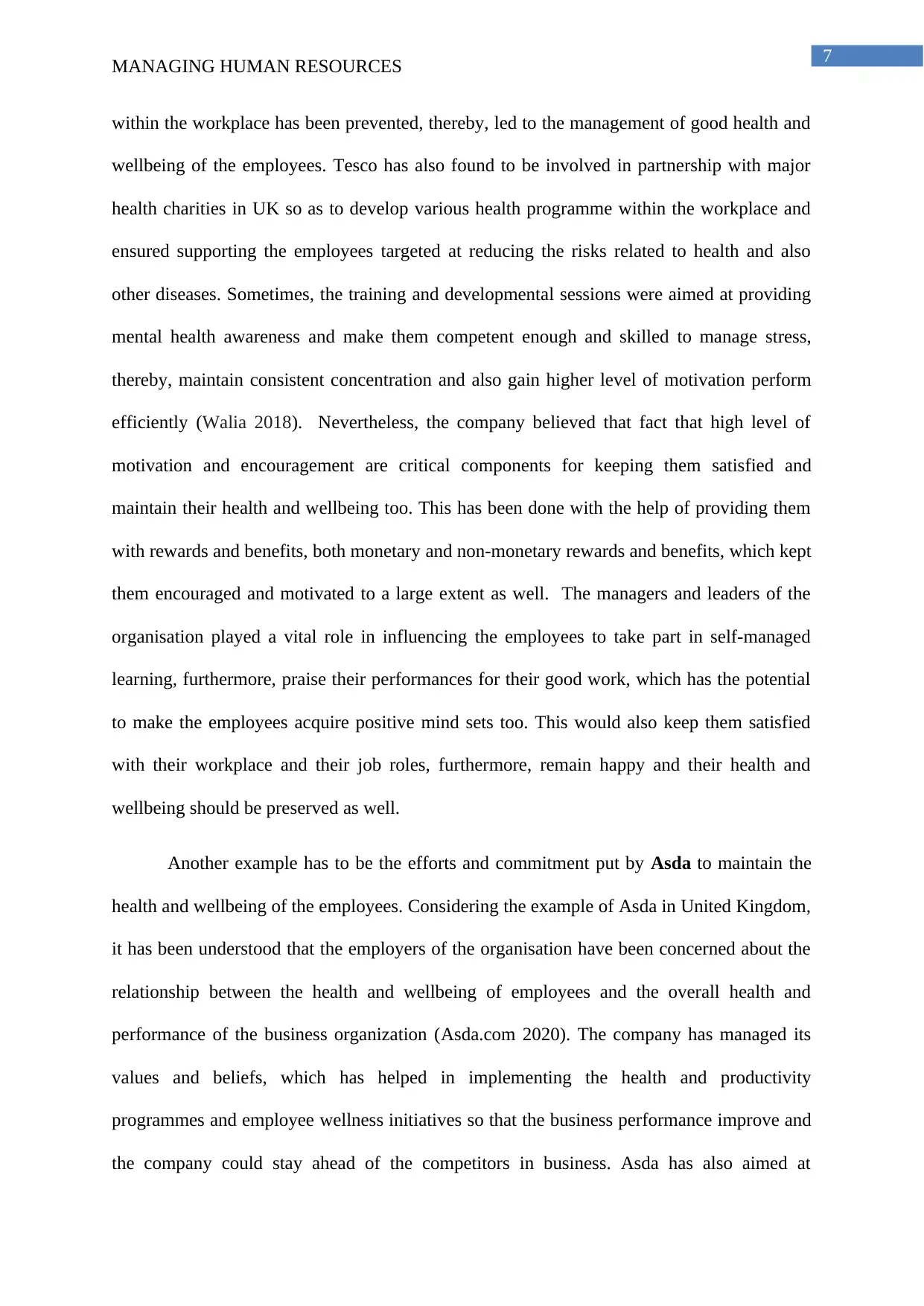
7
MANAGING HUMAN RESOURCES
within the workplace has been prevented, thereby, led to the management of good health and
wellbeing of the employees. Tesco has also found to be involved in partnership with major
health charities in UK so as to develop various health programme within the workplace and
ensured supporting the employees targeted at reducing the risks related to health and also
other diseases. Sometimes, the training and developmental sessions were aimed at providing
mental health awareness and make them competent enough and skilled to manage stress,
thereby, maintain consistent concentration and also gain higher level of motivation perform
efficiently (Walia 2018). Nevertheless, the company believed that fact that high level of
motivation and encouragement are critical components for keeping them satisfied and
maintain their health and wellbeing too. This has been done with the help of providing them
with rewards and benefits, both monetary and non-monetary rewards and benefits, which kept
them encouraged and motivated to a large extent as well. The managers and leaders of the
organisation played a vital role in influencing the employees to take part in self-managed
learning, furthermore, praise their performances for their good work, which has the potential
to make the employees acquire positive mind sets too. This would also keep them satisfied
with their workplace and their job roles, furthermore, remain happy and their health and
wellbeing should be preserved as well.
Another example has to be the efforts and commitment put by Asda to maintain the
health and wellbeing of the employees. Considering the example of Asda in United Kingdom,
it has been understood that the employers of the organisation have been concerned about the
relationship between the health and wellbeing of employees and the overall health and
performance of the business organization (Asda.com 2020). The company has managed its
values and beliefs, which has helped in implementing the health and productivity
programmes and employee wellness initiatives so that the business performance improve and
the company could stay ahead of the competitors in business. Asda has also aimed at
MANAGING HUMAN RESOURCES
within the workplace has been prevented, thereby, led to the management of good health and
wellbeing of the employees. Tesco has also found to be involved in partnership with major
health charities in UK so as to develop various health programme within the workplace and
ensured supporting the employees targeted at reducing the risks related to health and also
other diseases. Sometimes, the training and developmental sessions were aimed at providing
mental health awareness and make them competent enough and skilled to manage stress,
thereby, maintain consistent concentration and also gain higher level of motivation perform
efficiently (Walia 2018). Nevertheless, the company believed that fact that high level of
motivation and encouragement are critical components for keeping them satisfied and
maintain their health and wellbeing too. This has been done with the help of providing them
with rewards and benefits, both monetary and non-monetary rewards and benefits, which kept
them encouraged and motivated to a large extent as well. The managers and leaders of the
organisation played a vital role in influencing the employees to take part in self-managed
learning, furthermore, praise their performances for their good work, which has the potential
to make the employees acquire positive mind sets too. This would also keep them satisfied
with their workplace and their job roles, furthermore, remain happy and their health and
wellbeing should be preserved as well.
Another example has to be the efforts and commitment put by Asda to maintain the
health and wellbeing of the employees. Considering the example of Asda in United Kingdom,
it has been understood that the employers of the organisation have been concerned about the
relationship between the health and wellbeing of employees and the overall health and
performance of the business organization (Asda.com 2020). The company has managed its
values and beliefs, which has helped in implementing the health and productivity
programmes and employee wellness initiatives so that the business performance improve and
the company could stay ahead of the competitors in business. Asda has also aimed at
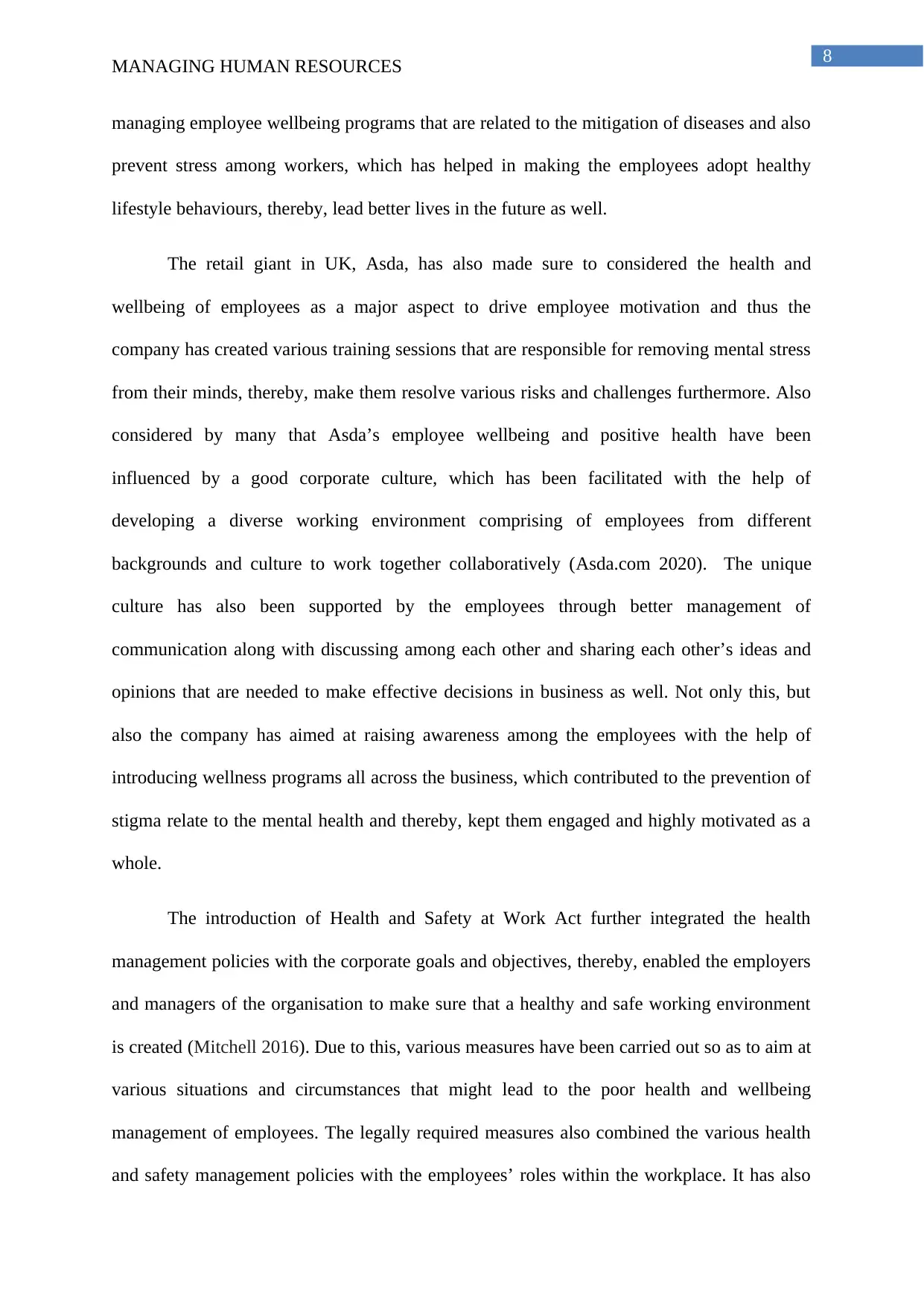
8
MANAGING HUMAN RESOURCES
managing employee wellbeing programs that are related to the mitigation of diseases and also
prevent stress among workers, which has helped in making the employees adopt healthy
lifestyle behaviours, thereby, lead better lives in the future as well.
The retail giant in UK, Asda, has also made sure to considered the health and
wellbeing of employees as a major aspect to drive employee motivation and thus the
company has created various training sessions that are responsible for removing mental stress
from their minds, thereby, make them resolve various risks and challenges furthermore. Also
considered by many that Asda’s employee wellbeing and positive health have been
influenced by a good corporate culture, which has been facilitated with the help of
developing a diverse working environment comprising of employees from different
backgrounds and culture to work together collaboratively (Asda.com 2020). The unique
culture has also been supported by the employees through better management of
communication along with discussing among each other and sharing each other’s ideas and
opinions that are needed to make effective decisions in business as well. Not only this, but
also the company has aimed at raising awareness among the employees with the help of
introducing wellness programs all across the business, which contributed to the prevention of
stigma relate to the mental health and thereby, kept them engaged and highly motivated as a
whole.
The introduction of Health and Safety at Work Act further integrated the health
management policies with the corporate goals and objectives, thereby, enabled the employers
and managers of the organisation to make sure that a healthy and safe working environment
is created (Mitchell 2016). Due to this, various measures have been carried out so as to aim at
various situations and circumstances that might lead to the poor health and wellbeing
management of employees. The legally required measures also combined the various health
and safety management policies with the employees’ roles within the workplace. It has also
MANAGING HUMAN RESOURCES
managing employee wellbeing programs that are related to the mitigation of diseases and also
prevent stress among workers, which has helped in making the employees adopt healthy
lifestyle behaviours, thereby, lead better lives in the future as well.
The retail giant in UK, Asda, has also made sure to considered the health and
wellbeing of employees as a major aspect to drive employee motivation and thus the
company has created various training sessions that are responsible for removing mental stress
from their minds, thereby, make them resolve various risks and challenges furthermore. Also
considered by many that Asda’s employee wellbeing and positive health have been
influenced by a good corporate culture, which has been facilitated with the help of
developing a diverse working environment comprising of employees from different
backgrounds and culture to work together collaboratively (Asda.com 2020). The unique
culture has also been supported by the employees through better management of
communication along with discussing among each other and sharing each other’s ideas and
opinions that are needed to make effective decisions in business as well. Not only this, but
also the company has aimed at raising awareness among the employees with the help of
introducing wellness programs all across the business, which contributed to the prevention of
stigma relate to the mental health and thereby, kept them engaged and highly motivated as a
whole.
The introduction of Health and Safety at Work Act further integrated the health
management policies with the corporate goals and objectives, thereby, enabled the employers
and managers of the organisation to make sure that a healthy and safe working environment
is created (Mitchell 2016). Due to this, various measures have been carried out so as to aim at
various situations and circumstances that might lead to the poor health and wellbeing
management of employees. The legally required measures also combined the various health
and safety management policies with the employees’ roles within the workplace. It has also
⊘ This is a preview!⊘
Do you want full access?
Subscribe today to unlock all pages.

Trusted by 1+ million students worldwide
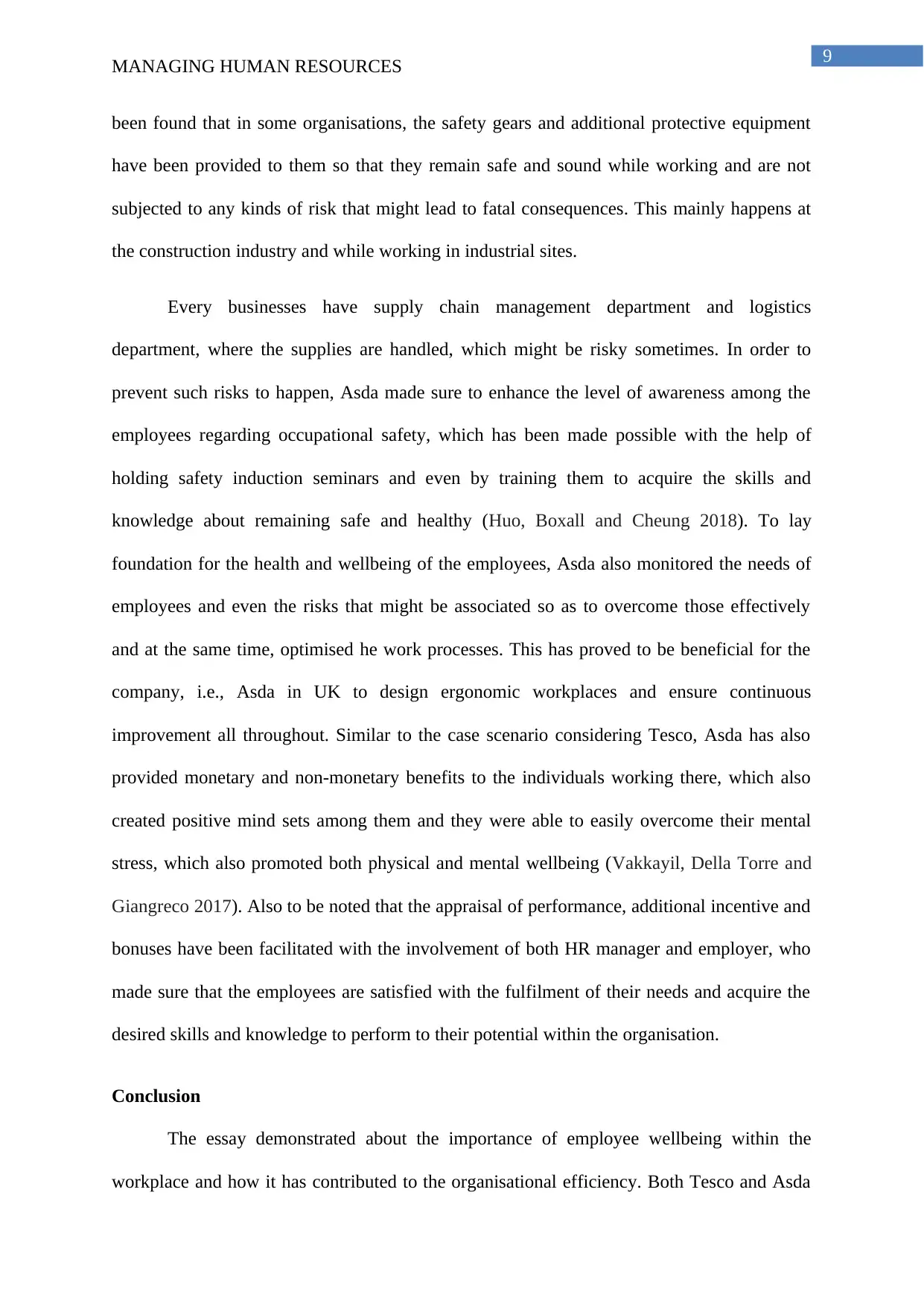
9
MANAGING HUMAN RESOURCES
been found that in some organisations, the safety gears and additional protective equipment
have been provided to them so that they remain safe and sound while working and are not
subjected to any kinds of risk that might lead to fatal consequences. This mainly happens at
the construction industry and while working in industrial sites.
Every businesses have supply chain management department and logistics
department, where the supplies are handled, which might be risky sometimes. In order to
prevent such risks to happen, Asda made sure to enhance the level of awareness among the
employees regarding occupational safety, which has been made possible with the help of
holding safety induction seminars and even by training them to acquire the skills and
knowledge about remaining safe and healthy (Huo, Boxall and Cheung 2018). To lay
foundation for the health and wellbeing of the employees, Asda also monitored the needs of
employees and even the risks that might be associated so as to overcome those effectively
and at the same time, optimised he work processes. This has proved to be beneficial for the
company, i.e., Asda in UK to design ergonomic workplaces and ensure continuous
improvement all throughout. Similar to the case scenario considering Tesco, Asda has also
provided monetary and non-monetary benefits to the individuals working there, which also
created positive mind sets among them and they were able to easily overcome their mental
stress, which also promoted both physical and mental wellbeing (Vakkayil, Della Torre and
Giangreco 2017). Also to be noted that the appraisal of performance, additional incentive and
bonuses have been facilitated with the involvement of both HR manager and employer, who
made sure that the employees are satisfied with the fulfilment of their needs and acquire the
desired skills and knowledge to perform to their potential within the organisation.
Conclusion
The essay demonstrated about the importance of employee wellbeing within the
workplace and how it has contributed to the organisational efficiency. Both Tesco and Asda
MANAGING HUMAN RESOURCES
been found that in some organisations, the safety gears and additional protective equipment
have been provided to them so that they remain safe and sound while working and are not
subjected to any kinds of risk that might lead to fatal consequences. This mainly happens at
the construction industry and while working in industrial sites.
Every businesses have supply chain management department and logistics
department, where the supplies are handled, which might be risky sometimes. In order to
prevent such risks to happen, Asda made sure to enhance the level of awareness among the
employees regarding occupational safety, which has been made possible with the help of
holding safety induction seminars and even by training them to acquire the skills and
knowledge about remaining safe and healthy (Huo, Boxall and Cheung 2018). To lay
foundation for the health and wellbeing of the employees, Asda also monitored the needs of
employees and even the risks that might be associated so as to overcome those effectively
and at the same time, optimised he work processes. This has proved to be beneficial for the
company, i.e., Asda in UK to design ergonomic workplaces and ensure continuous
improvement all throughout. Similar to the case scenario considering Tesco, Asda has also
provided monetary and non-monetary benefits to the individuals working there, which also
created positive mind sets among them and they were able to easily overcome their mental
stress, which also promoted both physical and mental wellbeing (Vakkayil, Della Torre and
Giangreco 2017). Also to be noted that the appraisal of performance, additional incentive and
bonuses have been facilitated with the involvement of both HR manager and employer, who
made sure that the employees are satisfied with the fulfilment of their needs and acquire the
desired skills and knowledge to perform to their potential within the organisation.
Conclusion
The essay demonstrated about the importance of employee wellbeing within the
workplace and how it has contributed to the organisational efficiency. Both Tesco and Asda
Paraphrase This Document
Need a fresh take? Get an instant paraphrase of this document with our AI Paraphraser
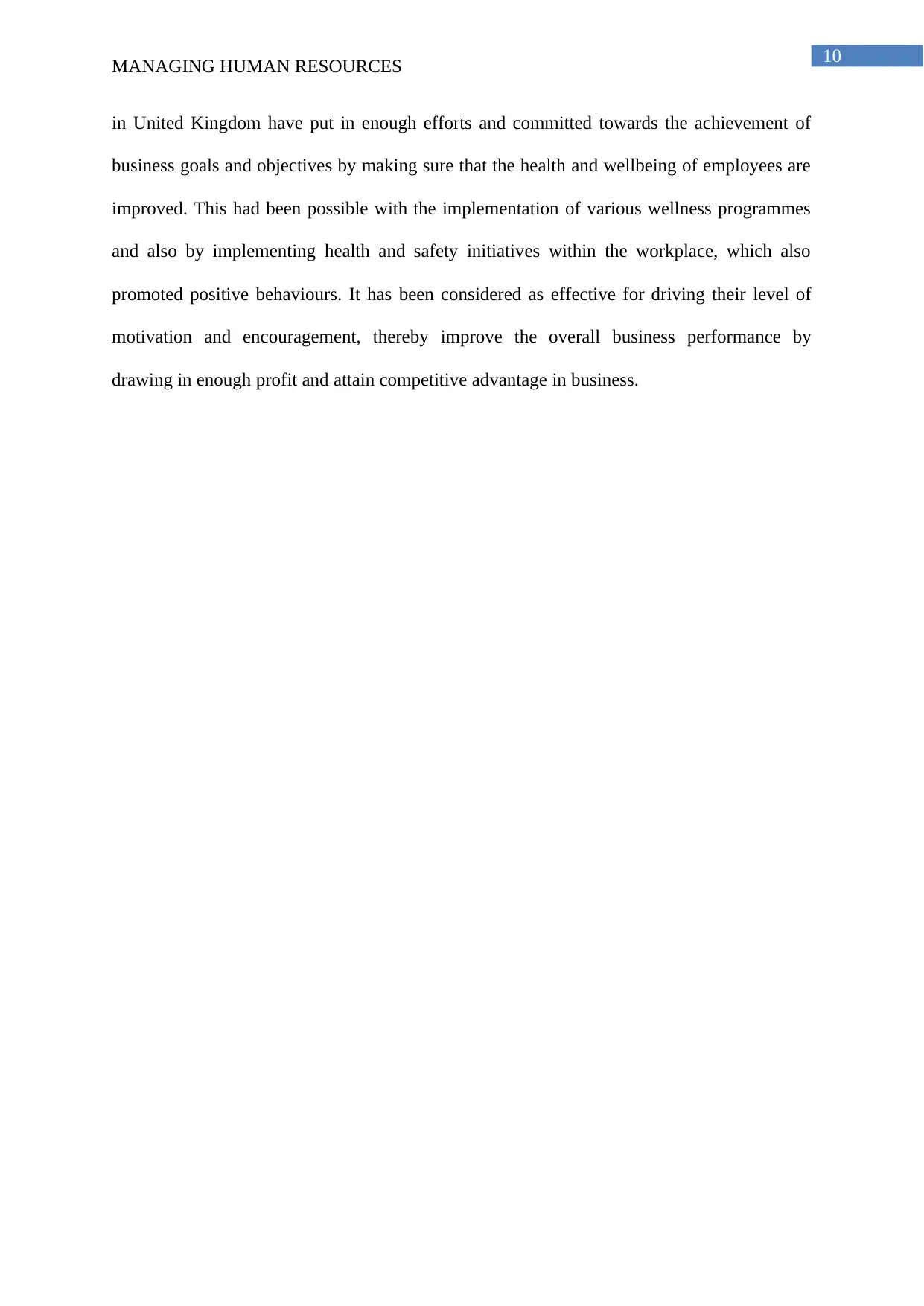
10
MANAGING HUMAN RESOURCES
in United Kingdom have put in enough efforts and committed towards the achievement of
business goals and objectives by making sure that the health and wellbeing of employees are
improved. This had been possible with the implementation of various wellness programmes
and also by implementing health and safety initiatives within the workplace, which also
promoted positive behaviours. It has been considered as effective for driving their level of
motivation and encouragement, thereby improve the overall business performance by
drawing in enough profit and attain competitive advantage in business.
MANAGING HUMAN RESOURCES
in United Kingdom have put in enough efforts and committed towards the achievement of
business goals and objectives by making sure that the health and wellbeing of employees are
improved. This had been possible with the implementation of various wellness programmes
and also by implementing health and safety initiatives within the workplace, which also
promoted positive behaviours. It has been considered as effective for driving their level of
motivation and encouragement, thereby improve the overall business performance by
drawing in enough profit and attain competitive advantage in business.
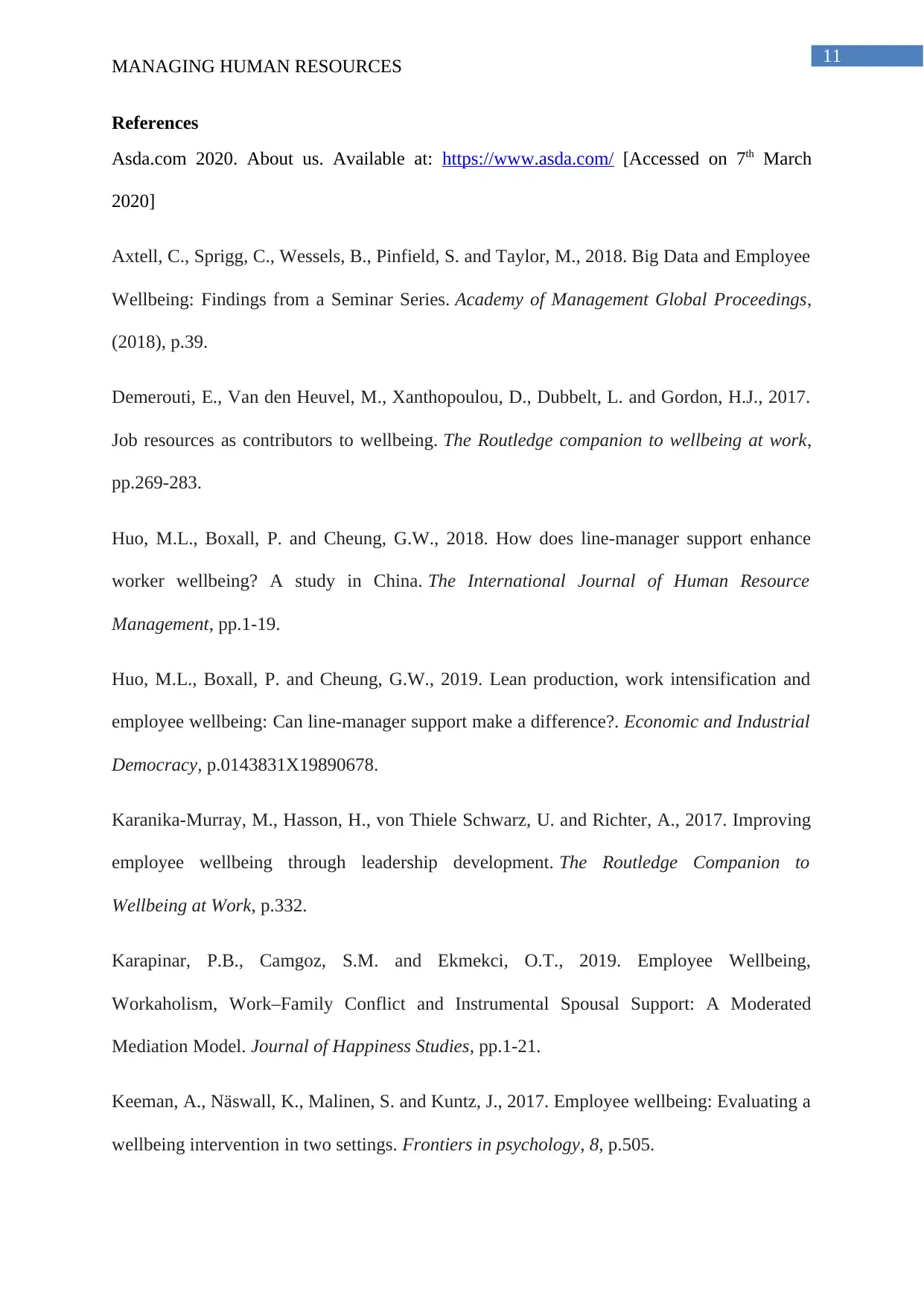
11
MANAGING HUMAN RESOURCES
References
Asda.com 2020. About us. Available at: https://www.asda.com/ [Accessed on 7th March
2020]
Axtell, C., Sprigg, C., Wessels, B., Pinfield, S. and Taylor, M., 2018. Big Data and Employee
Wellbeing: Findings from a Seminar Series. Academy of Management Global Proceedings,
(2018), p.39.
Demerouti, E., Van den Heuvel, M., Xanthopoulou, D., Dubbelt, L. and Gordon, H.J., 2017.
Job resources as contributors to wellbeing. The Routledge companion to wellbeing at work,
pp.269-283.
Huo, M.L., Boxall, P. and Cheung, G.W., 2018. How does line-manager support enhance
worker wellbeing? A study in China. The International Journal of Human Resource
Management, pp.1-19.
Huo, M.L., Boxall, P. and Cheung, G.W., 2019. Lean production, work intensification and
employee wellbeing: Can line-manager support make a difference?. Economic and Industrial
Democracy, p.0143831X19890678.
Karanika-Murray, M., Hasson, H., von Thiele Schwarz, U. and Richter, A., 2017. Improving
employee wellbeing through leadership development. The Routledge Companion to
Wellbeing at Work, p.332.
Karapinar, P.B., Camgoz, S.M. and Ekmekci, O.T., 2019. Employee Wellbeing,
Workaholism, Work–Family Conflict and Instrumental Spousal Support: A Moderated
Mediation Model. Journal of Happiness Studies, pp.1-21.
Keeman, A., Näswall, K., Malinen, S. and Kuntz, J., 2017. Employee wellbeing: Evaluating a
wellbeing intervention in two settings. Frontiers in psychology, 8, p.505.
MANAGING HUMAN RESOURCES
References
Asda.com 2020. About us. Available at: https://www.asda.com/ [Accessed on 7th March
2020]
Axtell, C., Sprigg, C., Wessels, B., Pinfield, S. and Taylor, M., 2018. Big Data and Employee
Wellbeing: Findings from a Seminar Series. Academy of Management Global Proceedings,
(2018), p.39.
Demerouti, E., Van den Heuvel, M., Xanthopoulou, D., Dubbelt, L. and Gordon, H.J., 2017.
Job resources as contributors to wellbeing. The Routledge companion to wellbeing at work,
pp.269-283.
Huo, M.L., Boxall, P. and Cheung, G.W., 2018. How does line-manager support enhance
worker wellbeing? A study in China. The International Journal of Human Resource
Management, pp.1-19.
Huo, M.L., Boxall, P. and Cheung, G.W., 2019. Lean production, work intensification and
employee wellbeing: Can line-manager support make a difference?. Economic and Industrial
Democracy, p.0143831X19890678.
Karanika-Murray, M., Hasson, H., von Thiele Schwarz, U. and Richter, A., 2017. Improving
employee wellbeing through leadership development. The Routledge Companion to
Wellbeing at Work, p.332.
Karapinar, P.B., Camgoz, S.M. and Ekmekci, O.T., 2019. Employee Wellbeing,
Workaholism, Work–Family Conflict and Instrumental Spousal Support: A Moderated
Mediation Model. Journal of Happiness Studies, pp.1-21.
Keeman, A., Näswall, K., Malinen, S. and Kuntz, J., 2017. Employee wellbeing: Evaluating a
wellbeing intervention in two settings. Frontiers in psychology, 8, p.505.
⊘ This is a preview!⊘
Do you want full access?
Subscribe today to unlock all pages.

Trusted by 1+ million students worldwide
1 out of 13
Related Documents
Your All-in-One AI-Powered Toolkit for Academic Success.
+13062052269
info@desklib.com
Available 24*7 on WhatsApp / Email
![[object Object]](/_next/static/media/star-bottom.7253800d.svg)
Unlock your academic potential
Copyright © 2020–2025 A2Z Services. All Rights Reserved. Developed and managed by ZUCOL.





